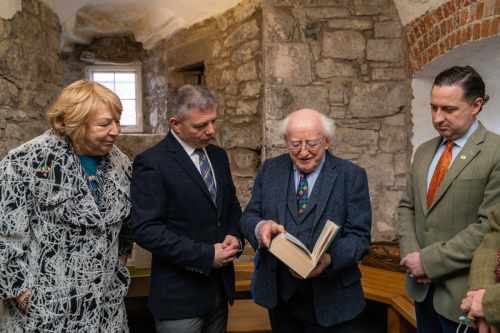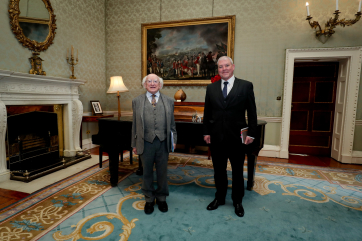Speech by President Michael D. Higgins Centenary Commemoration of the Clonmult Ambush
Clonmult, Dungourney, Co. Cork, Sunday, 20th February, 2022
A Thaoisigh, A Theachtaí Dála, A Cathaoirlaigh and Seanadoirí,
A Mhéara,
A Íonadaithe Poiblí uilig,
A chairde,
For me the photo that is on the cover of the Clonmult Commemorative Journal of 2021 is deeply moving. It is of young men in simple clothes, members of a Flying Column, to which independence was of such importance, that in this state of unpreparedness and inexperience, that in the pursuit of an ideal, they would take on an empire. It is appropriate that we recall their courage, their values, which led to our freedom and independence today.
Traosláim libh uilig – how grateful we should be to the family who host the monument.
From what circumstances were they drawn? If the First Brigade was of the same composition as the Fourth Brigade and its companies, of which my father was a member, it would have drawn widely. The Charleville company had 87 members. When he was First Lieutenant, the Battalion of which he was Intelligence Officer had 450. At this point there were those who were known as the trades, non-inheriting sons, future smallholders; the tragedy of the later Civil War would expose these divisions.
The Clonmult ambush that took place 101 years ago today, most obviously for the farmers who lost members and the community of which they were a part, was an event that carried lasting significance. Beyond such suffering and loss, it was an event with consequences that would play out on both sides during the remainder of the Irish War of Independence. The ambush was the Irish Republican Army’s (IRA) greatest loss in the War of Independence, coming, as it did, in the worst week of the campaign and just five days after three IRA men and nine civilians were killed in the disastrous Upton train ambush. Clonmult saw the biggest single loss of lives the IRA suffered in any engagement with British Crown Forces during the entirety of the War of Independence.
From the British perspective, the story of the Clonmult Ambush is notable as it revealed a change in the strategic approach by Crown Forces – the Army, RIC, Auxiliaries and Black and Tans – who had struggled in the aftermath of several IRA victories.
The recently passed Restoration of Order Act now permitted Crown Forces powers of arrest and internment. The toll of killings, the ambushes, raids and acts of sabotage rose steadily during the winter of 1921. The army of an empire that was celebrating what it saw as a success in a World War, from which it appeared stronger, was dealing with what it saw as a guerrilla force that had a hiding place and support within communities.
The Crown Forces, in their targeting of the IRA now adopted a more calculated approach to the War, and their use of intelligence sources enabled them to close in faster than before on the Volunteers who, as was the case in Clonmult, became surrounded by a force of British Army, Royal Irish Constabulary and Auxiliaries.
The story is well known to you all. IRA Volunteers from the Cork No. 1 Brigade had been occupying an abandoned farmhouse in Clonmult, County Cork, for six weeks. From there they had ranged with their activities across the country targeting British Forces. Their circumstances were however exceptional. The house was far from ideal from the perspective of any guerrilla force. For example, there was no back door which would facilitate a quick getaway, and the roof was thatched and thus vulnerable to arson.
Commanding officers had left the 20 or so Volunteers inside the farmhouse and had set out to undertake a reconnaissance of Cobh Junction to plan an ambush. They remained there until the 20th of February, 1921, when a detachment from the Hampshire regiment arrived at a neighbouring farmhouse. They saw two IRA men, Michael Desmond and John Joe Joyce, drawing water from a well, and shot them dead.
Soon another eight-man patrol arrived at the house. Despite the overwhelming force against them, five men, including Captain Jack O’Connell, attempted to escape by fighting their way out of the house. O’Connell was the only one who managed to flee, and both Mick Hallinan and Dick Hegarty were fatally wounded. The prospects for the rest of the men dwindled further when two truckloads of auxiliary police, 24 men in all, emerged on the scene.
The ensuing attack saw the Crown Forces set fire to the thatch to burn the men out of the house. Defiantly the men inside threw their guns on the fire rather than surrender them. The ammunition reportedly exploded creating a ferocious racket.
What happened next has been described in the historiography as “Kilmichael in reverse” after the famous ambush in November 1920 when 16 auxiliaries were killed, some allegedly after a false surrender. In what can be labelled as an obvious reprisal, seven men were shot without warning by the Auxiliaries, many people believing then, as now, in retaliation for Kilmichael. The Hampshire Regiment claimed the men were shot when they engaged in a false surrender.
The men who were killed included Jeremiah Ahern and his first-cousin Liam Ahern, Donal Dennehy, David Desmond, James Glavin, Joseph Morrissey and Christopher O’Sullivan. The battle that had begun at 4pm had ended within about two hours. Of the eight taken prisoner at Clonmult, two – Maurice Moore and Patrick O’Sullivan – were subsequently hanged.
In retaliation, what could be termed a counter-reprisal, the IRA executed six spies they suspected of being involved with the British authorities. A total of 22 people died in the ambush, the subsequent execution of the IRA Volunteers and the subsequent murders of alleged informers – 14 IRA members, 2 Black and Tans and 6 suspected informers.
The response on the part of the British Forces in Clonmult, that of a reprisal form of violence, had become well established by this point in the War of Independence. The philosophy behind the reprisals, while rooted in the British army’s attempting as an Imperial Force to re-assert control, often involved resorting to arbitrary violence, not only against republican activists, but often their surrounding civilian population who were sheltering them perceived to be in collusion with them in their struggle.
An unofficial government policy of reprisals with a community impact had begun in September 1919 in Fermoy, County Cork, when 200 British soldiers looted and burned the main businesses of the town, after one of their soldiers, Private William Jones, the first British Army death in the campaign, had been killed in an armed raid by the local IRA.
The pattern of killings and reprisals escalated in the second half of 1920 and into 1921. Several other reprisals occurred, which had a very deep community effect on all classes, such as the indiscriminate killing of Eileen Quinn, which drew international comment in the House of Commons itself. Eileen Quinn was shot dead while seven months’ pregnant as she stood outside her house in County Galway with her three children by her side.
Much of such reprisal-based violence was not sanctioned; indeed, officially sanctioned reprisals did not commence until January 1921, with the burning of seven houses in Midleton, County Cork.
The move by the British forces to target their attacks on co-operative creameries – which were major employers and sources of essential foodstuffs – marked an escalation in both the wider socio-economic impact and the sophistication of reprisal tactics.
The death and destruction unleashed by the War of Independence, illustrates how the forms of violence in conflict imitates what is known and internalised as violence, how violence has a brutalising effect, and produces extremes of further new forms of violence that are no longer within the control of the original instigators, a violence too sometimes characterised by a decidedly economic dimension, and in the case of both the War of Independence and the Civil War, as recent research shows, had a gender component in specific circumstances.
Both guerrilla warfare and reprisals saw a loss of life and widespread destruction of homesteads that extended into the civilian sphere, into the lives of those not directly involved.
Today, we explore this past, not to air inherited grievances or seek justification for injustices perpetrated against us or atrocities inflicted in our name. Contrasting atrocities is futile and, in its being selective, indeed evasive, can be amoral. An act of ethical commemoration requires more. It must respect fact and context and then move on, free to live the present and its new challenges, envisage a future that is inclusive of all. It must be recognised, however painful that it is, and be inclusive. There are areas which up to now have their details hidden.
Another example of difficult recall will be the treatment of the stories of those over 12,000 incarcerated during the Civil War. There are the stories such as those of Joseph Campbell, a story for which we are indebted to Éilean Ní Chuilleanáin of those over 3,000 prisoners at any time in the huts at Tintown. While my Uncle Peter was in the National Army in Renmore, his brother John, my father, was in Hut 3 in Tintown and would be released in December 1923.
We must have that deeper purpose, and it is my suggestion that such purpose should be to gain a clearer understanding of what factually occurred and the different versions as to what was the context, and acknowledging the fullness and difference as to the paths that has led us to where we find ourselves today. We have the opportunity for a generous critical version of ethical memory.
Allowing ourselves to be open to the perspectives of others as to their difference or learned versions or rationalisations provides the possibility of hope to extricate ourselves from the grip of any uncritical, simplistic version of our complex story. It enables a deeper collective understanding that frees us for a shared inclusive future.
There were others, such as how the agricultural labourers were coming to be seen as a threat, not allies, but the forces of Nationalism that emerged from the War of Independence and the tragedy of the Civil War.
I suggest that we will need hospitality of narratives, one that rejects any false amnesia, essential if we wish to pursue an ethical version of remembrance, and commemoration. Such an approach can enable us to grasp together the possibilities for a brighter future together, based on mutual respect, common interests and trust, one that may aid a process of healing for us all as we reflect on these events which gave us our independence but have also marked us so profoundly as a society.
The prize of an inclusive commemoration, authentic as to fact, considerate as to impact, one that becomes emancipatory in its consequences, is now there for us to grasp, one that allows for not only courage but uncomfortable truths to be acknowledged, including forms of violence and exclusion we have or may have avoided.
It is an approach that allows us to envisage lives lived together, characterised by courage, a courage such as that which impelled those we commemorate today to take on what was an enormous confrontation with an empire and its overwhelming military resources, but whose courage in their time and circumstances gave us the space to exercise our independence, gifted us with responsibilities in freedom that we must not neglect, must achieve in new circumstances together.
Go raibh míle maith agaibh agus beir beannacht.



